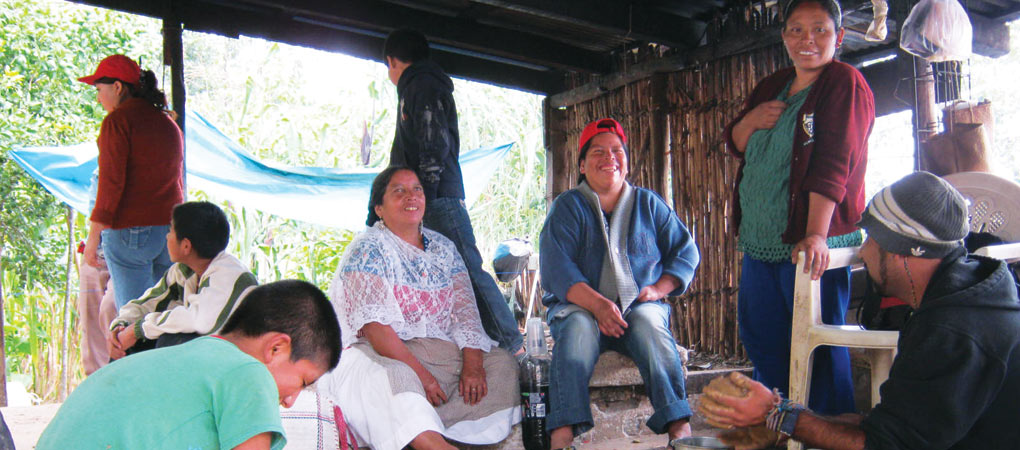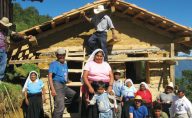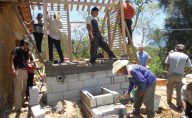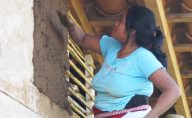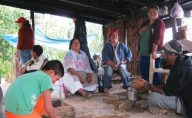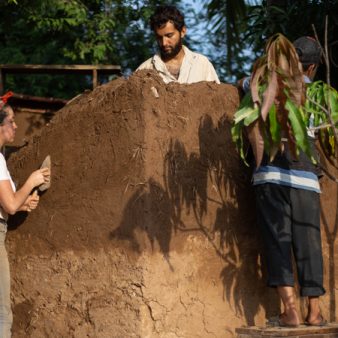Indigenous communities in the Sierra Norte de Puebla region in Mexico live in extreme poverty in houses that are inadequate to protect people from strong rains. The project focused on the right to adequate housing for these communities. It provided social and technical assistance, and access to finance based on social financing combined with public subsidy to purchase materials; enabling people to build their own homes using traditional building practices and locally available materials.
Project Description
What are its aims and objectives?
Indigenous people building their homes was initiated in 2009 by CIUDEMAC in partnership with COPEVI. The project is community-led and focused on ensuring the right to adequate, affordable, environmentally sustainable housing for low-income indigenous families in rural areas, while preserving traditional culture and building practices.
What context does it operate in?
Indigenous communities in the Sierra Norte de Puebla region in rural Mexico live in conditions of severe poverty, inequality and social exclusion. More than 20 per cent of the population live in houses with mud floors and roofs made of corrugated sheets, wood, cardboard or tin, without access to basic infrastructure and services, often located in high-risk areas and vulnerable to strong rains. Access to government funding often requires families to obtain credit from financial institutions, which is not viable where there are such high levels of poverty and exclusion, being either inaccessible or leaving household heavily in debt. The project seeks to improve living conditions and demonstrate an alternative, sustainable, people-centred approach.
Mexico’s history of paternalistic government policies has had the effect of engendering a culture of dependency within many communities. COPEVI and CIUDEMAC have worked together to increase awareness, develop a sense of commitment and encourage self-management and autonomy.
Government policies in Mexico generally do not take into consideration the specific housing needs of indigenous groups, or of communities living in rural areas. COPEVI and the Social Production of Housing network have worked to articulate these needs and gain recognition within government that rural and indigenous housing processes have particular aspects that differ from urban housing issues.
The project has been carried out within the framework of the 2006 National Housing Law, which formally recognised people-led housing processes (‘social production of housing’), following long-standing efforts by grassroots organisations, academia, NGOs and other civil society organisations.
What are its key features?
The project has developed a comprehensive, community-driven, rights-based approach. Partnerships between organisations, innovative funding and sensitivity to local culture, traditional building practices and environmental sustainability are fundamental.
Led by COPEVI, the project has benefited from successful partnerships between a range of organisations.
CIUDEMAC and its members have taken a central role, including the selection of participating families, monitoring of on-site work, communications and development of local capacity. The partnership has enabled CIUDEMAC to acquire knowledge and experience in project management, construction, advocacy and collective decision-making, and transfer that knowledge to its members.
Technical support is provided through the COPEVI architects who were trained in the use of local materials through a partnership with Mesoamerikaab (a regional platform that promotes the use of local building materials).
The German development agency Misereor encouraged the initial design of the initiative and linked to earth construction specialists with the project. This support allows carrying out traditional construction processes based on earth. Misereor also provided core funding for COPEVI.
CONAVI provided federal funding for the project through its housing subsidy programme for community-led housing. An innovative funding mechanism for the project was developed through a partnership between COPEVI and local NGO Pobladores, which combines state subsidies with ‘social credit’ (in-kind contributions of building materials and labour by participating families).
Working to widen the impact, the ‘Social Production of Housing’ network of non-governmental and civil society organisations, of which COPEVI is a member, has been involved in policy and advocacy efforts to increase funding for grassroots housing processes.
Minimising the ecological footprint, making use of environmentally sustainable building materials and preserving traditional indigenous building practices is a key focus of the project. Locally-sourced materials with low embodied energy, including earth/adobe, water, stone, timber, sand and gravel, have been used in housing construction, with small amounts of iron and cement used where necessary. COPEVI and CIUDEMAC have worked to increase awareness of sustainable building practices amongst participating communities and the success of the project has encouraged families who might otherwise have preferred conventional/industrial building materials to value traditional, earth-based construction.
How is it funded?
The total capital costs of the project were US$2.63 million, of which 50.5 per cent has been obtained from the Mexican National Housing Commission (CONAVI), through its programme of subsidies for community-led housing construction, with the remaining 49.5 per cent obtained through what has been termed ‘social financing’, or in-kind contributions of building materials and labour by participating families. Technical assistance has been provided by COPEVI, with financial and technical support from the German international development agency Misereor.
Each 60m2 house costs, on average, US$6,150. Residents are responsible for maintaining their homes and each household has contributed US$77 to a communal fund, which now stands at US$34,000.
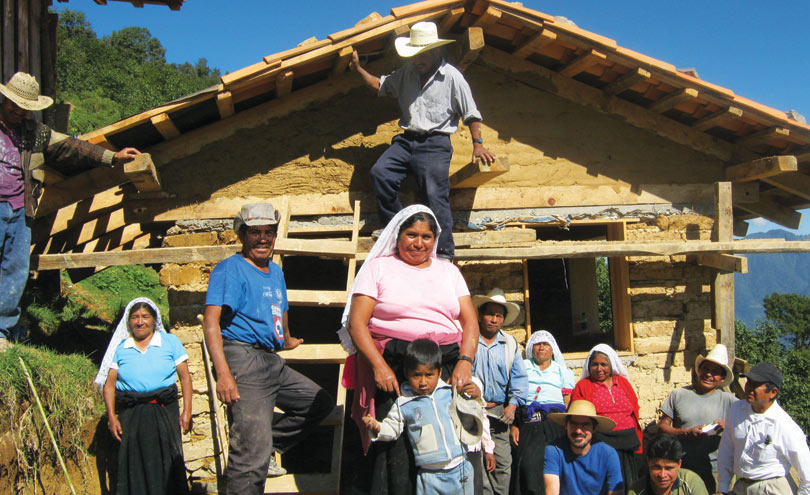
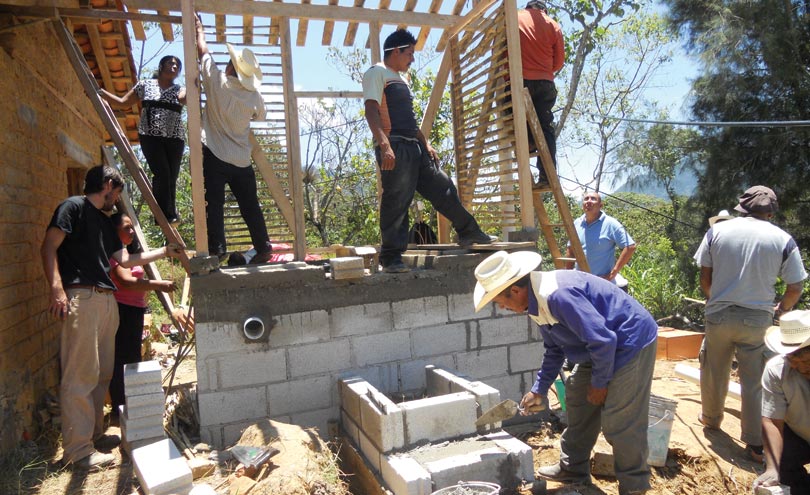
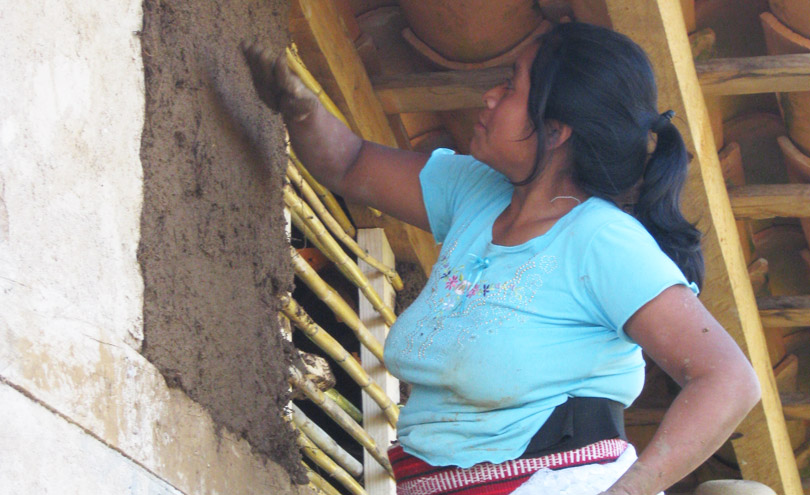
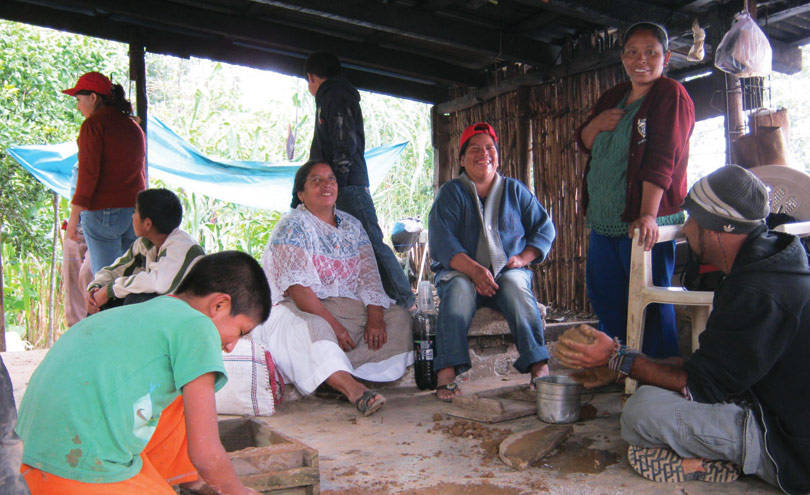
What impact has it had?
The project was initiated in 2009 with the construction of its first 20 houses, with 428 houses completed to date. A wider community development strategy was implemented in 2011 and the project is currently in feedback and transfer stages.
CIUDEMAC is currently partnering with the Tosepantomin cooperative to expand the approach and is working with COPEVI and a range of other organisations and networks to influence public policy and improve access to decent housing.
The main sector benefiting from the project are 16 low-income indigenous communities groups living in rural areas in the municipalities of Zacatlán, Tetela de Ocampo and Tepetzintla in the Sierra Norte de Puebla region in Mexico.
In addition to supporting income generation and local economic development, the project has worked to develop local leadership and community decision-making structures, both within individual communities and between the 16 different participating communities.
The project has benefitted approximately 3,000 people (22 per cent of the total population in the area) through housing improvements in the last five years and is in the process of being expanded to other areas.
Positive impacts for the communities include improved housing conditions and healthier living spaces, improved indoor air quality and greater protection from the strong rains that are prevalent in the region. Residents speak of the emotion they felt on having their dreams realised, of feeling safe from the rain and of their satisfaction with their new homes.
The mutual aid construction process has brought neighbours together and there is an increased appreciation for the use of local building materials. Dialogue between different generations of builders has contributed towards rescuing some traditional building techniques that had been lost, primarily regarding earth-based construction. Houses are larger and of significantly higher quality compared to conventional houses built by construction companies.
COPEVI and the ‘Social Production of Housing’ network of non-governmental and civil society organisations have worked to influence public policy and increase the amount of state funding available for community-led housing processes. Together they have succeeded in obtaining recognition at policy level of the value of non-traditional finance schemes, i.e. in-kind and labour contributions (‘social financing’) and their inclusion as the residents’ counterpart in accessing housing subsidies. As a result, housing is significantly more affordable and accessible to people than it was prior to the project, as residents are able to access public housing subsidies without having to obtain costly loans which they would either not have been eligible for or would have been unable to repay. The improvements enabled by the project help to generate income and employment opportunities and stimulate local economic development.
COPEVI is currently scaling up the approach to two other regions – Zoatecpan in Puebla, and the Mixteca Alta de Oaxaca region, working with small groups of indigenous families (including an indigenous women’s group, with municipal government support). CIUDEMAC has a waiting list of 145 families looking to carry out similar projects.
The approach has been adopted by various member organisations of the Red de Productores Sociales de Vivienda del Sureste (community-led housing network) and is also in the process of being transferred to the state of Oaxaca by grassroots organisation CODEP, adapting the funding scheme and building 40 houses.
In 2011, the project was highlighted as an example of best practice at a high-level meeting of the National Housing Commission (CONAVI) and senior government officials. In 2012, it received a special mention in a Latin American competition for housing projects that promote the right to the city, sustainability and good living practices, organised by the Habitat International Coalition on the occasion of the Rio+20 United Nations Conference on Sustainable Development.
Why is it innovative?
- Comprehensive, community-driven, rights-based approach – addressing the needs of the most vulnerable through a holistic approach that considers social, environmental, economic and cultural aspects.
- Financing scheme that works for the poor and provides an alternative to traditional paternalistic government approaches, combining public and social subsidy and placing a value on residents’ labour and in-kind contributions.
- Building technical and financial alliances with key partners (CIUDEMAC, CONAVI, Misereor).
- Demonstrating a practical result of an innovative legal and financial framework (Housing Law 2006, PSV fund).
What is the environmental impact?
A key focus of the project has been on minimising the ecological footprint, making use of environmentally sustainable building materials and preserving traditional indigenous building practices. Locally-sourced materials with low embodied energy, including earth/adobe, water, stone, timber, sand and gravel, have been used in housing construction, with small amounts of iron and cement used where necessary. COPEVI and CIUDEMAC have worked to increase awareness of sustainable building practices amongst participating communities and the success of the project has encouraged families who might otherwise have preferred conventional/industrial building materials to value traditional, earth-based construction.
As the project progressed, a range of eco-technologies were developed and included in the construction of the houses to ensure a more appropriate use of energy and water resources. It is currently a requirement for at least one eco-technology to be integrated into each new housing unit, including rainwater harvesting, dry composting toilets, backyard orchard and fuel-efficient stoves.
A fundamental characteristic of the local culture relates to the cuidado de la Madre Tierra (preservation of Mother Earth), and this has guided various aspects of the project. Following the construction of the homes, community groups have begun to develop plans for additional actions to improve their living environment, including a number of reforestation projects.
Is it financially sustainable?
The project has enabled families to access existing government housing subsidies. Whilst there is a possibility that the policy framework and subsidies schemes may change in future, participating communities and organisations are now better equipped to deal with issues affecting their right to adequate housing and develop alternative funding solutions.
What is the social impact?
The project is community led and residents have been actively involved in all aspects of the process, with participation at the following three levels: the board of directors, a decision-making body comprised of representatives of each of the 16 indigenous community groups involved in the project; community committees responsible for information sharing, recordkeeping, convening assemblies and setting key priorities; and participation by all families in the construction process itself, through traditional mutual aid processes. Training has been provided by COPEVI and its partners on technical, social, governance and legal aspects. Over the last five years CIUDEMAC has significantly improved its leadership and organisational structures and is now working to support other organisations.
The mutual aid process helps to confirm the sense of belonging, increases self-esteem, provides greater security and enables residents to subsequently address other problems they may be facing.
The project has generated local employment, the creation of ten micro-enterprises and a community fund (with a US$77 contribution by each household), as well as supporting the local economy through the purchase of materials from local suppliers. CIUDEMAC has recently been working with families to carry out and manage communal savings projects – for example, for the construction of a community kitchen and a youth centre.
Through the project, COPEVI has worked to reduce existing social inequalities and improve the living conditions of marginalised indigenous groups. Women have played a leading role in the construction and governance processes and some participating communities have begun to develop programmes that aim to empower women and young people.
Barriers
- Conceptual barrier: as government policies in Mexico generally do not take into consideration the specific housing needs of indigenous groups, or of communities living in rural areas, COPEVI and the Social Production of Habitat network have worked to articulate these needs and gain recognition within government that rural and indigenous housing processes have particular aspects that differ from urban housing issues.
- Access to public resources: it is very difficult for low-income rural families to obtain access to government housing subsidies, as these are generally given to large organisations with strong political influence or require households to obtain loans which are unaffordable and/or inaccessible for the poor. In partnership with local NGO Pobladores, COPEVI has worked to increase access to existing housing subsidies for participating families and in the wider sphere.
- Cultural barrier: Mexico’s history of paternalistic government policies has had the effect of engendering a culture of dependency within many communities. COPEVI and CIUDEMAC have worked together to increase awareness, develop a sense of commitment and encourage a can-do, self-management approach through the project.
Lessons Learned
- Building solid partnerships with other organisations has been a key factor in the success of the project, allowing for the exchange of knowledge and experience and consolidating an approach that covers diverse areas, e.g. political relationships, financial aspects, local building systems, communication with indigenous communities in their own language etc – which COPEVI, on its own, would not have had the capacity to manage.
- The fact that COPEVI works at both ends of the spectrum – from public advocacy to direct action – has been a significant advantage, allowing them to take part in high-level policy debates as well as implementation on the ground.
- The construction of a school at the beginning of the project played an important role in understanding the reasons for acceptance or rejection of the use of local materials as well as bringing together the technical team and local builders.
- Although most indigenous communities work together in the collective interest, in many cases the construction of housing was understood as a process carried out by families rather than communities. Existing practices of collective construction and exchange were mainly observed in communities with strong levels of organisation and leadership.
- The positive economic impact has been greatest for those who previously worked in the construction industry – more work in building capacities and partnerships is necessary to enable financially viable enterprises to be established.
- Midway through the project an evaluation was carried out, resulting in the development of more specific criteria for the selection of participating families, with specific requirements for materials and labour contributions.
Evaluation
Whilst a formal external evaluation has not taken place, a continuous process of feedback and reflection has enabled COPEVI to adapt and improve its approach over time. The project is currently in the final feedback and transfer stages.
Transfer
COPEVI is currently scaling up the approach to two other regions – Zoatecpan in Puebla, and the Mixteca Alta de Oaxaca region, working with small groups of indigenous families (including an indigenous women’s group, with municipal government support). CIUDEMAC has a waiting list of 145 families looking to carry out similar projects.
CIUDEMAC and COPEVI have carried out peer exchanges and hosted meetings with members of other grassroots organisations interested in learning from their experience, e.g. the Centro para el Desarrollo Rural (Rural Development Studies Centre – CESDER).
The approach has been adopted by various member organisations of the Red de Productores Sociales de Vivienda del Sureste (community-led housing network) and is also in the process of being transferred to the state of Oaxaca by grassroots organisation CODEP, adapting the funding scheme and building 40 houses. There has been no international transfer as yet.

